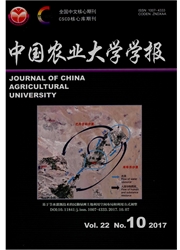

 中文摘要:
中文摘要:
以盐胁迫下苹果的耐盐砧木珠眉海棠为材料,用SMART^TM方法构建了eDNA文库。随机挑取5000个cDNA克隆制备芯片,得到差异表达的基因388个,其中249个表达上调、139个表达下调。分析其中变化量在8倍以上的42个基因,并对部分基因进行RT—PCR验证,结果与芯片杂交结果一致。根据功能把这些基因分为5类:光合作用相关基因、物质转运相关基因、基础代谢相关基因、逆境相关基因以及其他基因。其中直接参与盐应答的基因占34%,包括上游调控蛋白、合成植体内小分子渗透调节物的限速酶、胁迫产生的活性氧清除剂、直接调节离子运输和储存的蛋白等。用此cDNA微列阵体系,将基因芯片技术与cDNA文库相结合,成为全面研究盐胁迫下基因表达的有效途径。为进一步研究盐应答基因功能及盐胁迫机制提供参考。
 英文摘要:
英文摘要:
A cDNA library was constructed in Malus zumi Mats under salt stress by SMARTTM . 5 000 cDNA clones were randomly selected for microarray analysis. 388 genes were identified responding to salt stress,among which 249 genes were up-regulated and 139 genes down-regulated. 42 genes,whose expression changed more than 8 folds under salt stress were sequenced. 4 genes selcted for RT-PCR analysis showed similar expression pattern with microarry. The 42 genes can be classified into 5 groups: photosynthesis-related genes, transport-related genes, metabolism-related genes, stress-related genes and the others genes. The results showed that salt stress influenced many aspects of plant growth in M. zumi Mats~ some of these genes may play important roles in plant salt tolerance. Our findings may result in further functional study of salt-response genes in M. zumi Mats and the elucidation of its molecular mechanism of response, to salt stress.
 同期刊论文项目
同期刊论文项目
 同项目期刊论文
同项目期刊论文
 期刊信息
期刊信息
